Yiyi Chen
NLP Security and Ethics, in the Wild
Apr 09, 2025Abstract:As NLP models are used by a growing number of end-users, an area of increasing importance is NLP Security (NLPSec): assessing the vulnerability of models to malicious attacks and developing comprehensive countermeasures against them. While work at the intersection of NLP and cybersecurity has the potential to create safer NLP for all, accidental oversights can result in tangible harm (e.g., breaches of privacy or proliferation of malicious models). In this emerging field, however, the research ethics of NLP have not yet faced many of the long-standing conundrums pertinent to cybersecurity, until now. We thus examine contemporary works across NLPSec, and explore their engagement with cybersecurity's ethical norms. We identify trends across the literature, ultimately finding alarming gaps on topics like harm minimization and responsible disclosure. To alleviate these concerns, we provide concrete recommendations to help NLP researchers navigate this space more ethically, bridging the gap between traditional cybersecurity and NLP ethics, which we frame as ``white hat NLP''. The goal of this work is to help cultivate an intentional culture of ethical research for those working in NLP Security.
Trustworthy Machine Learning via Memorization and the Granular Long-Tail: A Survey on Interactions, Tradeoffs, and Beyond
Mar 10, 2025Abstract:The role of memorization in machine learning (ML) has garnered significant attention, particularly as modern models are empirically observed to memorize fragments of training data. Previous theoretical analyses, such as Feldman's seminal work, attribute memorization to the prevalence of long-tail distributions in training data, proving it unavoidable for samples that lie in the tail of the distribution. However, the intersection of memorization and trustworthy ML research reveals critical gaps. While prior research in memorization in trustworthy ML has solely focused on class imbalance, recent work starts to differentiate class-level rarity from atypical samples, which are valid and rare intra-class instances. However, a critical research gap remains: current frameworks conflate atypical samples with noisy and erroneous data, neglecting their divergent impacts on fairness, robustness, and privacy. In this work, we conduct a thorough survey of existing research and their findings on trustworthy ML and the role of memorization. More and beyond, we identify and highlight uncharted gaps and propose new revenues in this research direction. Since existing theoretical and empirical analyses lack the nuances to disentangle memorization's duality as both a necessity and a liability, we formalize three-level long-tail granularity - class imbalance, atypicality, and noise - to reveal how current frameworks misapply these levels, perpetuating flawed solutions. By systematizing this granularity, we draw a roadmap for future research. Trustworthy ML must reconcile the nuanced trade-offs between memorizing atypicality for fairness assurance and suppressing noise for robustness and privacy guarantee. Redefining memorization via this granularity reshapes the theoretical foundation for trustworthy ML, and further affords an empirical prerequisite for models that align performance with societal trust.
How Do Hackathons Foster Creativity? Towards AI Collaborative Evaluation of Creativity at Scale
Mar 06, 2025Abstract:Hackathons have become popular collaborative events for accelerating the development of creative ideas and prototypes. There are several case studies showcasing creative outcomes across domains such as industry, education, and research. However, there are no large-scale studies on creativity in hackathons which can advance theory on how hackathon formats lead to creative outcomes. We conducted a computational analysis of 193,353 hackathon projects. By operationalizing creativity through usefulness and novelty, we refined our dataset to 10,363 projects, allowing us to analyze how participant characteristics, collaboration patterns, and hackathon setups influence the development of creative projects. The contribution of our paper is twofold: We identified means for organizers to foster creativity in hackathons. We also explore the use of large language models (LLMs) to augment the evaluation of creative outcomes and discuss challenges and opportunities of doing this, which has implications for creativity research at large.
Large Language Models are Easily Confused: A Quantitative Metric, Security Implications and Typological Analysis
Oct 17, 2024
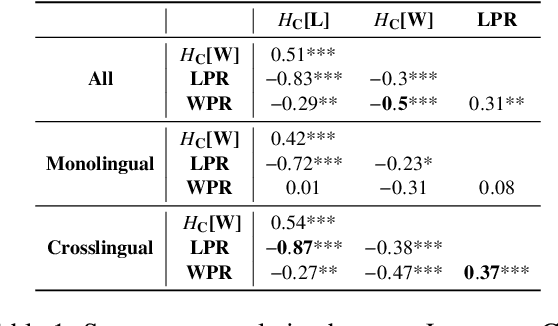

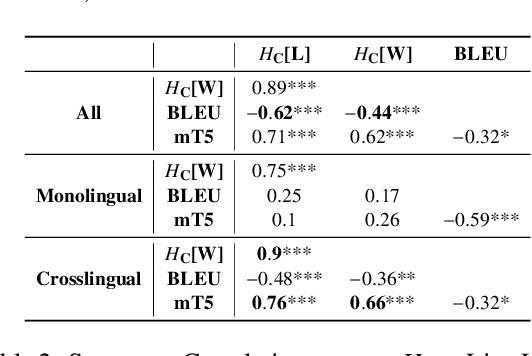
Abstract:Language Confusion is a phenomenon where Large Language Models (LLMs) generate text that is neither in the desired language, nor in a contextually appropriate language. This phenomenon presents a critical challenge in text generation by LLMs, often appearing as erratic and unpredictable behavior. We hypothesize that there are linguistic regularities to this inherent vulnerability in LLMs and shed light on patterns of language confusion across LLMs. We introduce a novel metric, Language Confusion Entropy, designed to directly measure and quantify this confusion, based on language distributions informed by linguistic typology and lexical variation. Comprehensive comparisons with the Language Confusion Benchmark (Marchisio et al., 2024) confirm the effectiveness of our metric, revealing patterns of language confusion across LLMs. We further link language confusion to LLM security, and find patterns in the case of multilingual embedding inversion attacks. Our analysis demonstrates that linguistic typology offers theoretically grounded interpretation, and valuable insights into leveraging language similarities as a prior for LLM alignment and security.
Against All Odds: Overcoming Typology, Script, and Language Confusion in Multilingual Embedding Inversion Attacks
Aug 21, 2024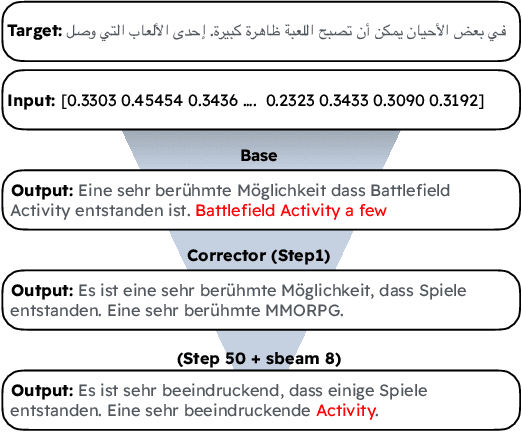
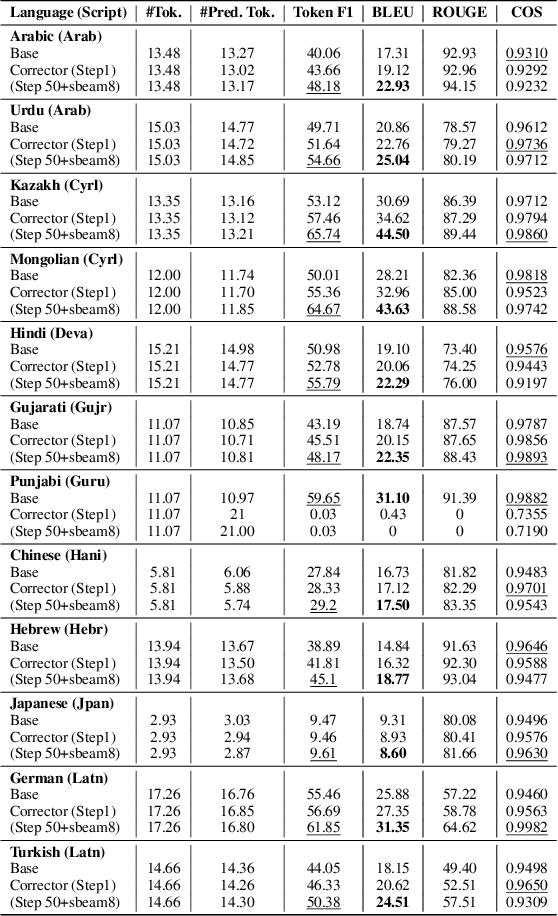

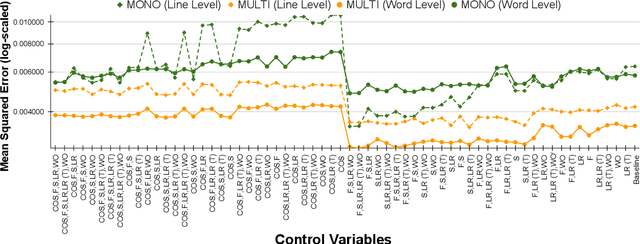
Abstract:Large Language Models (LLMs) are susceptible to malicious influence by cyber attackers through intrusions such as adversarial, backdoor, and embedding inversion attacks. In response, the burgeoning field of LLM Security aims to study and defend against such threats. Thus far, the majority of works in this area have focused on monolingual English models, however, emerging research suggests that multilingual LLMs may be more vulnerable to various attacks than their monolingual counterparts. While previous work has investigated embedding inversion over a small subset of European languages, it is challenging to extrapolate these findings to languages from different linguistic families and with differing scripts. To this end, we explore the security of multilingual LLMs in the context of embedding inversion attacks and investigate cross-lingual and cross-script inversion across 20 languages, spanning over 8 language families and 12 scripts. Our findings indicate that languages written in Arabic script and Cyrillic script are particularly vulnerable to embedding inversion, as are languages within the Indo-Aryan language family. We further observe that inversion models tend to suffer from language confusion, sometimes greatly reducing the efficacy of an attack. Accordingly, we systematically explore this bottleneck for inversion models, uncovering predictable patterns which could be leveraged by attackers. Ultimately, this study aims to further the field's understanding of the outstanding security vulnerabilities facing multilingual LLMs and raise awareness for the languages most at risk of negative impact from these attacks.
Spatiotemporal Graph Guided Multi-modal Network for Livestreaming Product Retrieval
Jul 24, 2024Abstract:With the rapid expansion of e-commerce, more consumers have become accustomed to making purchases via livestreaming. Accurately identifying the products being sold by salespeople, i.e., livestreaming product retrieval (LPR), poses a fundamental and daunting challenge. The LPR task encompasses three primary dilemmas in real-world scenarios: 1) the recognition of intended products from distractor products present in the background; 2) the video-image heterogeneity that the appearance of products showcased in live streams often deviates substantially from standardized product images in stores; 3) there are numerous confusing products with subtle visual nuances in the shop. To tackle these challenges, we propose the Spatiotemporal Graphing Multi-modal Network (SGMN). First, we employ a text-guided attention mechanism that leverages the spoken content of salespeople to guide the model to focus toward intended products, emphasizing their salience over cluttered background products. Second, a long-range spatiotemporal graph network is further designed to achieve both instance-level interaction and frame-level matching, solving the misalignment caused by video-image heterogeneity. Third, we propose a multi-modal hard example mining, assisting the model in distinguishing highly similar products with fine-grained features across the video-image-text domain. Through extensive quantitative and qualitative experiments, we demonstrate the superior performance of our proposed SGMN model, surpassing the state-of-the-art methods by a substantial margin. The code is available at https://github.com/Huxiaowan/SGMN.
Text Embedding Inversion Attacks on Multilingual Language Models
Jan 22, 2024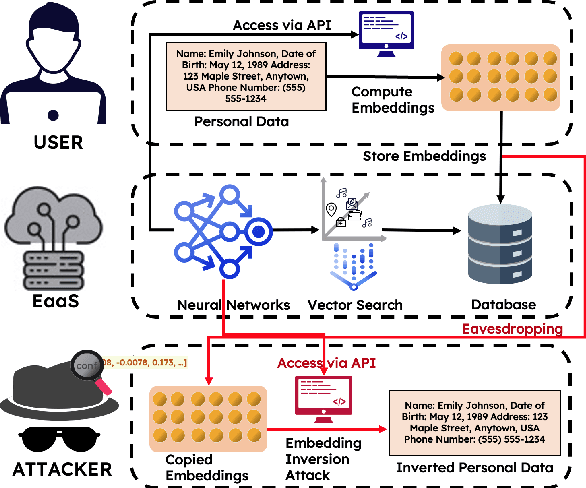
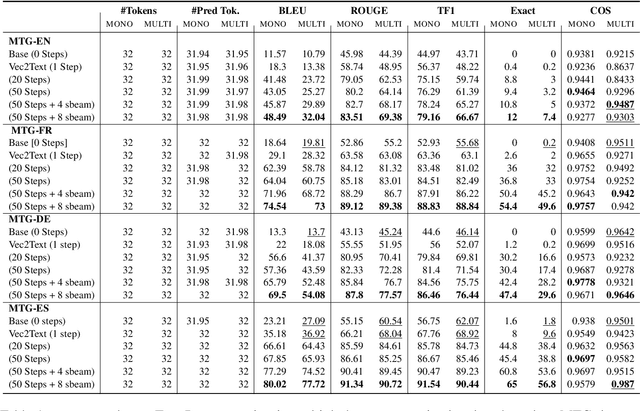

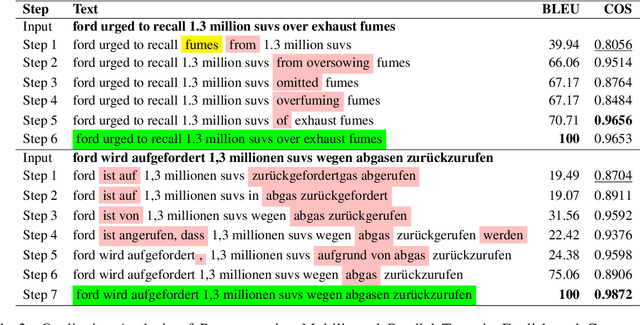
Abstract:Representing textual information as real-numbered embeddings has become the norm in NLP. Moreover, with the rise of public interest in large language models (LLMs), Embeddings as a Service (EaaS) has rapidly gained traction as a business model. This is not without outstanding security risks, as previous research has demonstrated that sensitive data can be reconstructed from embeddings, even without knowledge of the underlying model that generated them. However, such work is limited by its sole focus on English, leaving all other languages vulnerable to attacks by malicious actors. %As many international and multilingual companies leverage EaaS, there is an urgent need for research into multilingual LLM security. To this end, this work investigates LLM security from the perspective of multilingual embedding inversion. Concretely, we define the problem of black-box multilingual and cross-lingual inversion attacks, with special attention to a cross-domain scenario. Our findings reveal that multilingual models are potentially more vulnerable to inversion attacks than their monolingual counterparts. This stems from the reduced data requirements for achieving comparable inversion performance in settings where the underlying language is not known a-priori. To our knowledge, this work is the first to delve into multilinguality within the context of inversion attacks, and our findings highlight the need for further investigation and enhanced defenses in the area of NLP Security.
Patterns of Persistence and Diffusibility across the World's Languages
Jan 05, 2024



Abstract:Language similarities can be caused by genetic relatedness, areal contact, universality, or chance. Colexification, i.e. a type of similarity where a single lexical form is used to convey multiple meanings, is underexplored. In our work, we shed light on the linguistic causes of cross-lingual similarity in colexification and phonology, by exploring genealogical stability (persistence) and contact-induced change (diffusibility). We construct large-scale graphs incorporating semantic, genealogical, phonological and geographical data for 1,966 languages. We then show the potential of this resource, by investigating several established hypotheses from previous work in linguistics, while proposing new ones. Our results strongly support a previously established hypothesis in the linguistic literature, while offering contradicting evidence to another. Our large scale resource opens for further research across disciplines, e.g.~in multilingual NLP and comparative linguistics.
Patterns of Closeness and Abstractness in Colexifications: The Case of Indigenous Languages in the Americas
Dec 18, 2023Abstract:Colexification refers to linguistic phenomena where multiple concepts (meanings) are expressed by the same lexical form, such as polysemy or homophony. Colexifications have been found to be pervasive across languages and cultures. The problem of concreteness/abstractness of concepts is interdisciplinary, studied from a cognitive standpoint in linguistics, psychology, psycholinguistics, neurophysiology, etc. In this paper, we hypothesize that concepts that are closer in concreteness/abstractness are more likey to colexify, and we test the hypothesis across indigenous languages in Americas.
CreoleVal: Multilingual Multitask Benchmarks for Creoles
Oct 30, 2023Abstract:Creoles represent an under-explored and marginalized group of languages, with few available resources for NLP research. While the genealogical ties between Creoles and other highly-resourced languages imply a significant potential for transfer learning, this potential is hampered due to this lack of annotated data. In this work we present CreoleVal, a collection of benchmark datasets spanning 8 different NLP tasks, covering up to 28 Creole languages; it is an aggregate of brand new development datasets for machine comprehension, relation classification, and machine translation for Creoles, in addition to a practical gateway to a handful of preexisting benchmarks. For each benchmark, we conduct baseline experiments in a zero-shot setting in order to further ascertain the capabilities and limitations of transfer learning for Creoles. Ultimately, the goal of CreoleVal is to empower research on Creoles in NLP and computational linguistics. We hope this resource will contribute to technological inclusion for Creole language users around the globe.
 Add to Chrome
Add to Chrome Add to Firefox
Add to Firefox Add to Edge
Add to Edge